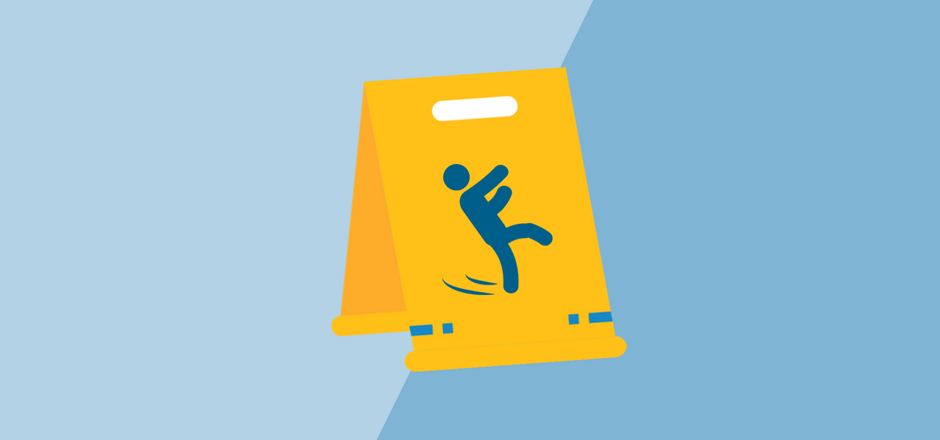10 Painfully Common Slip and Fall Injuries ⚠

Accidents involving a slip and fall are painfully common.
As the leading cause of unintentional injury in the U.S., slip and fall injuries are not to be taken lightly. Today, we’re taking a closer look at some of the most common slip and fall injuries and their risk factors.
Here are the top 10 most common slip and fall injuries.
The Most Common Slip and Fall Injuries
Accidents involving a slip and fall may result in a wide range of personal injury, including everything from minor cuts and sprains to hip fracture and spinal chord damage.
Slip and fall injuries are caused by a variety of unsafe conditions, including uneven steps, water, and clutter. With that said, risk factors may also include vision problems, balance difficulty, and medicine interactions.
It’s in your best interest to minimize these risk factors as much as possible, especially if you’re a senior citizen or you’ve recently experienced a slip and fall. Now, on to the most common slip and fall injuries …
1. Sprains
The elderly are perhaps more prone to sprains through sporadic physical activity or lack of muscle control, but sprains can happen to anyone and can be as painful and difficult to heal as fractures. Overextending joints and tendons can lead to long periods of recovery.
2. Broken arms or legs
Broken bones can range from minor fractures to severe breaks needing one or more surgeries. The tissue surrounding the breaks may also be damaged, necessitating long-term therapy to prevent chronic pain and neuromuscular dysfunction.
People who grab objects while falling or use their hands to break falls can fracture their wrists or arms.
Suspected breaks need imaging like X-Ray or MRI procedures to verify significance and extent of the injury. Often, casts or braces are required and patients are immobilized or severely limited in the range of motion.
3. Shoulder injuries
Shoulders can be damaged in a couple of different ways. The rotor cuff can be damaged and require surgery. The shoulder itself can be dislocated when there is a sudden downward pressure on the shoulder as your head is pushed up and away from that shoulder.
Shoulder dislocation is known as “brachial plexus injury.” The brachial plexus is a network of nerves that are connected to the spinal cord, shoulder, arm, and hand.
Shoulder injuries. A slip-and-fall accident may result in a shoulder dislocation or an injury known as a “brachial plexus injury.” The brachial plexus is a network of nerves connecting the spinal cord to the shoulder, arm, and hand. These painful injuries are treated with surgery followed by physical therapy to rehabilitate the injured limb and joint.
4. Hip fractures
The CDC reports that more than 95 percent of hip fractures are caused by falls. Hip fractures are serious injuries requiring surgery, hospital stays, and nursing home rehabilitation. They can also require artificial-hip replacement and in worse cases, can lead to fatality. According to the CDC, one in five hip-fracture patients dies within one year of their injury. And according to the Journal of the American Medical Association, the mortality rate among older women doubles in the first year after having a broken hip.
5. Back and spinal cord injuries
Falls can damage the spinal cord, vertebrae or discs resulting in varying degrees of pain, loss of function, and paralysis. The Spinal cord injuries occur when the spinal cord is severed or compressed and can be life-threatening.
High cervical spinal-cord injuries can result in quadriplegia (full paralysis) while injuries lower in the spinal cord can result in paraplegia (partial paralysis involving the lower limbs). There can be permanent or temporary paralysis as well as other neurological and sensory impairments.
According to the Mayo Clinic, more than a quarter of spinal cord injuries overall are caused by falls, and falls cause the most spinal cord injuries among seniors 65 and older.
6. Head injuries
Any head injury can be a medical emergency. Head injuries from falls can result in bleeding, swelling, and loss of consciousness. Injuries can include concussions or more seriously, traumatic brain injuries (TBI).
The full health impact from head injuries may not be known for a long time. Injured parties may think they feel fine at the time but that can change. Damage may not show up for weeks, months, or even years.
7. Soft Tissue Injuries
Soft tissue injuries aren’t outwardly visible but they can be very painful. Left untreated, Injuries to soft tissues can lead to chronic pain and create susceptibility to further injury.
8. Cuts and Abrasions
Slips and falls can produce cuts and abrasions that are less serious than other injuries but they can still cause pain and require attention. They may need only minor treatment but if left untreated can lead to infections and more serious consequences.
Superficial cuts and abrasions may get the first attention but they may also mask other injuries that should be investigated including muscle and skeletal injury.
9. Torn tendons and ligaments
Torn tendons or ligaments can have long-term consequences with extended recovery periods, pain, and loss of full mobility. In many cases, these injuries can be corrected only by surgery.
One of the more common ligament injuries is to the knee. The ligaments usually impacted are the anterior cruciate ligament (ACL) or Posterior Cruciate Ligament (PCL). These ligaments are often damaged when athletes are involved in unexpected or violent collisions or over-stressing.
The knee can be injured in other ways as well, including meniscus damage, hyperextension, or dislocation of the kneecap.
10. Eye injuries
Falls are a common cause of accidental eye injuries and can be very painful as well as life-changing. Injuries include corneal abrasions (scratches), penetration of a foreign object, chemical burns from acidic or alkali foreign substances.
Swollen eyelids can result from being hit. And eyes can bleed due to subconjunctival hemorrhaging, which is the result of broken blood vessels.
Very serious injuries include hyphema (bleeding in the anterior chamber of the eye) and orbital blowout fractures (cracks or breaks in the facial bones surrounding the eye). These can be emergency situations.
Eye injuries usually require seeing an ophthalmologist for diagnosis and treatment.
Statute of limitations
California’s statute of limitations for personal injury cases provides the injured person two years from the date of the injury to file a lawsuit against the responsible party. After that, your right to compensation will be forfeit. If you have suffered any injury from a slip or fall, you should contact an attorney for the best possible outcome.
The California statute of limitations for filing a personal injury case can be found at California Code of Civil Procedure section 335.1.

Are you in search for a certified attorney to represent you?
Let us help you find one today!

